Last Updated on 3 months by Francis
The Sistine Chapel, adorned with Michelangelo’s breathtaking frescoes, is a true masterpiece of art. These magnificent paintings, depicting scenes from the Bible, are a testament to Michelangelo’s unparalleled talent and skill. In this article, we will uncover the secrets behind the techniques and step-by-step process that Michelangelo employed to create these awe-inspiring frescoes.
Contents
Key Takeaways:
- Michelangelo’s frescoes in the Sistine Chapel are renowned for their beauty and complexity.
- The painting techniques and process used by Michelangelo remain a source of fascination and intrigue.
- Understanding the secrets behind Michelangelo’s frescoes enhances our appreciation of his artistic genius.
- The Sistine Chapel continues to captivate visitors from around the world with its timeless artistry.
- The preservation and restoration efforts ensure that future generations can experience the splendor of these frescoes.
The Background of the Sistine Chapel
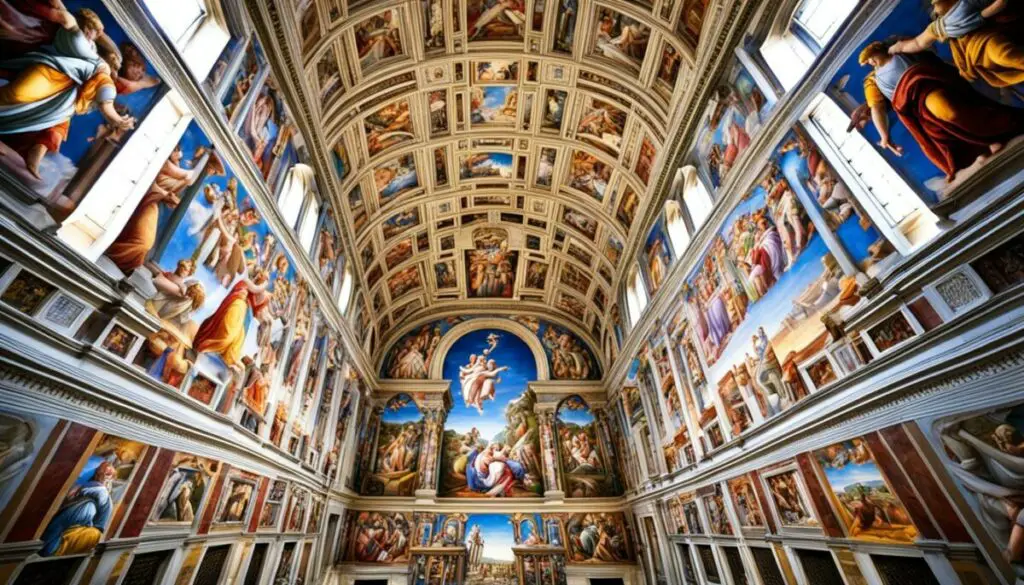
During the High Renaissance period, which spanned from 1490 to 1530, Italian masters like Leonardo da Vinci, Michelangelo, and Raphael created exquisite works of art influenced by the aesthetic ideals of ancient Greek and Roman civilizations. These artists sought to capture and express the heavenly beauty associated with the divine. In this competitive environment, Michelangelo and Leonardo engaged in a fierce rivalry, pushing the boundaries of artistic innovation. Pope Julius II played a significant role in inviting these artists to Rome and transforming the Vatican into a center of artistic achievement.
The High Renaissance was characterized by a renewed interest in classical beauty and a desire to depict the divine in art. Artists during this period emphasized balance, harmony, and naturalism in their works, drawing inspiration from the humanist ideals of the time. Michelangelo, Leonardo da Vinci, and Raphael were at the forefront of this artistic movement, creating masterpieces that still mesmerize viewers today.
Italian Masters
Leonardo da Vinci, known for his technical prowess and scientific curiosity, painted iconic works such as the Mona Lisa and The Last Supper. Michelangelo, a sculptor and painter, left an indelible mark on the art world with his magnificent sculptures, including David and Pieta, as well as the awe-inspiring frescoes of the Sistine Chapel. Raphael, celebrated for his graceful and harmonious compositions, produced renowned works such as The School of Athens and The Sistine Madonna. Together, these Italian masters embodied the aesthetic ideals and artistic brilliance of the High Renaissance.
Aesthetic Ideals and Beauty
The High Renaissance artists strived to capture and portray the divine beauty they believed resided within the human form. Their artworks depicted gods, goddesses, and saints with idealized features and an ethereal radiance. Through their meticulous attention to detail, these artists sought to evoke a sense of spiritual transcendence and evoke a profound emotional response in viewers. By infusing their works with beauty and grace, they aimed to convey the divine presence in the world around them.
“Beauty is the purgation of superfluous elements.” – Leonardo da Vinci
The city of Florence, known as the birthplace of the Renaissance, played a significant role in shaping the artistic landscape of the time. Artists flocked to this cultural hub to study classical art, philosophy, and literature. From Florence, the Renaissance ideals spread to other Italian cities, such as Rome, where powerful patrons like Pope Julius II provided opportunities for artistic expression and innovation. The works of these Italian masters, with their timeless beauty and divine inspirations, continue to captivate audiences and serve as a testament to the artistic achievements of the High Renaissance.
The Sistine Chapel as a Masterpiece
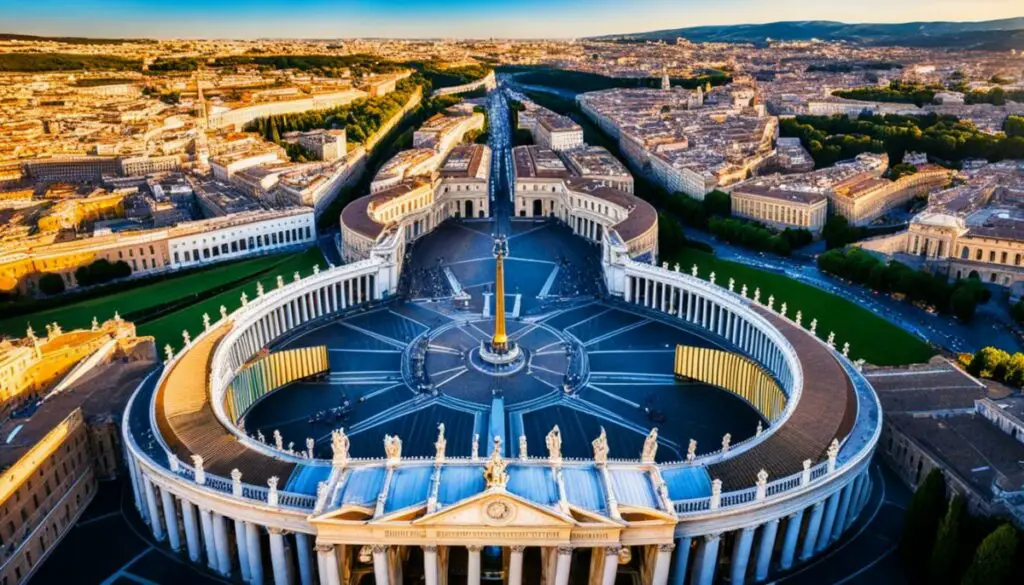
The Sistine Chapel, located in Vatican City, is not only a popular tourist attraction but also a significant venue for ecclesiastical affairs. Named after Pope Sixtus IV, who commissioned its construction in the 1470s, this magnificent chapel showcases impressive dimensions and original paintings by renowned artists. Although the chapel initially featured artworks by Botticelli and Rosselli, Michelangelo’s commission transformed it into his magnum opus.
The design of the Sistine Chapel reflects the symmetry and grandeur of Solomon’s temple, creating a visually stunning space. With a vaulted ceiling that was originally intended to depict the night sky, the chapel’s artistic value extends beyond its iconic frescoes. Let’s explore the dimensions and original paintings that make the Sistine Chapel a true masterpiece.
Michelangelo’s Reluctance and Challenges
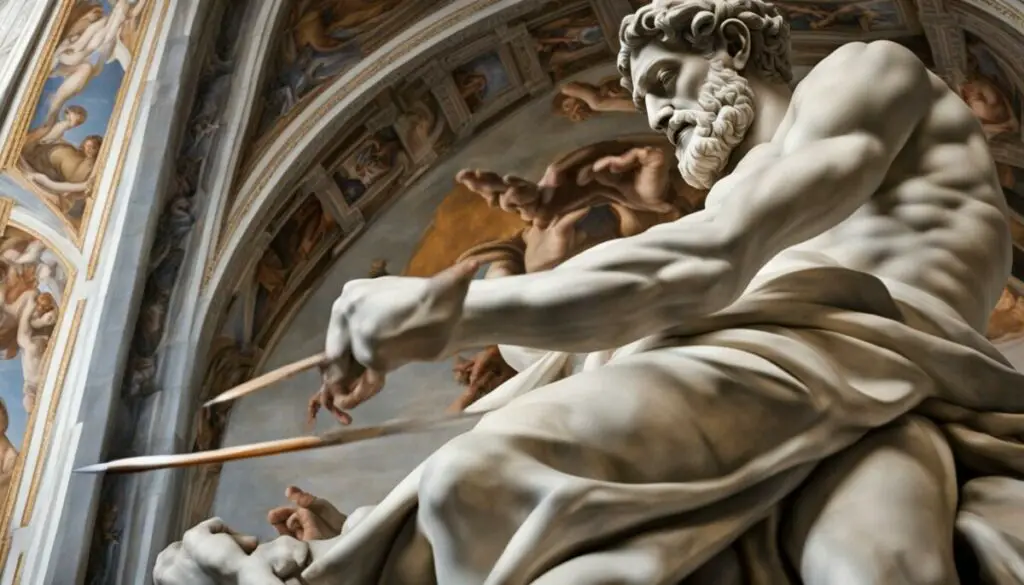
When Pope Julius II requested Michelangelo to paint the ceiling of the Sistine Chapel, the renowned sculptor was initially hesitant. As someone with no prior experience in fresco painting, Michelangelo had dedicated his time and effort to other artistic endeavors. The idea of undertaking such a monumental task, combined with the physical discomfort it would entail, presented additional challenges.
Painting on a high ceiling meant that Michelangelo would have to constantly crane his neck, causing considerable discomfort and strain. Moreover, the risk of paint dripping onto his face added to his reluctance to take on the commission. Despite these setbacks, Michelangelo eventually agreed to the project, recognizing the immense opportunity it presented to showcase his artistic prowess.
To tackle the challenges of working on the ceiling, Michelangelo took matters into his own hands. He designed a bespoke scaffold specifically for the purpose of painting the frescoes, rejecting another artist’s flawed support structure. This allowed him to create a conducive environment that minimized the physical discomfort and facilitated his creative process.
“I am a sculptor, not a painter,” Michelangelo reportedly said when faced with the commission. However, it was this very reluctance that pushed him to overcome his own reservations and create one of the most iconic artistic masterpieces in history.
By embracing the challenge and pushing his artistic boundaries, Michelangelo left an indelible mark on the world with his magnificent frescoes in the Sistine Chapel.
Michelangelo’s Ingenious Scaffold Design
Michelangelo’s scaffold design was a crucial element in enabling him to complete the monumental task of painting the ceiling of the Sistine Chapel. The scaffold provided the necessary support and stability for him to carry out his work at such heights. It allowed him to maneuver comfortably above the ground, ensuring that he had the control and access required to bring his artistic vision to life.
“The discomfort of my position eats away at my body,” Michelangelo wrote in a letter to a friend, highlighting the physical toll the project took on him. Despite the challenges and strain, he persevered, driven by his unwavering dedication to his craft and his desire to create something truly extraordinary.
| Challenges Faced | Michelangelo’s Solutions |
|---|---|
| Resistance due to lack of experience in fresco painting | Agreed to the commission and embraced the opportunity to showcase his talent |
| Discomfort and strain from craning his neck and dealing with paint dripping | Designed his own scaffold, rejecting another artist’s flawed support structure |
| Physical toll on his body | Persevered with determination and unwavering dedication to his craft |
Michelangelo’s Vision for the Ceiling

Michelangelo’s commission to paint the Sistine Chapel initially involved portraying the twelve apostles on the pendentives of the chapel. However, his artistic vision expanded the project’s scope, transforming the center of the ceiling into a narrative masterpiece. Within the confines of the Sistine Chapel, he depicted captivating scenes from Genesis, adorned the walls with figures of biblical significance, and created the monumental painting known as The Last Judgment.
Rejecting the constraints of the initial commission, Michelangelo demanded complete artistic control to bring his grand vision to life. He adorned the Sistine Chapel’s ceiling with biblical scenes, capturing the stories of the ancestors of Christ and past popes. Through his masterful brushstrokes, he transformed the chapel into a mesmerizing space that evoked a sense of awe and reverence.
The pinnacle of Michelangelo’s artistic achievement within the Sistine Chapel is undoubtedly The Last Judgment. This epic painting, located behind the altar, spans an astonishing 5000 square feet and showcases the final judgment of humanity as imagined in religious texts. The painting depicts prophetic figures, including Jesus Christ, surrounded by captivating symbolism that encapsulates the narrative of salvation.
With his transformative vision, Michelangelo turned the Sistine Chapel into a visual narrative, immersing viewers in powerful biblical scenes and evoking a profound sense of spirituality. The sheer scale and intricacy of his frescoes within the chapel remain a testament to his unrivaled artistic genius.
The image above captures the awe-inspiring beauty of the Sistine Chapel, showcasing Michelangelo’s visionary artistry.
The Significance of the Ceiling Paintings

The paintings on the ceiling of the Sistine Chapel are considered a significant milestone in the history of art, showcasing the evolution of Renaissance styles. Michelangelo’s skillful use of linear perspective, naturalistic forms, and later, the Mannerist feature of experimental forms, exemplifies the artistic ideals of the time.
Iconic scenes such as The Creation of Adam, The Flood, and The Original Sin highlight Michelangelo’s mastery of composition, expression, and storytelling. Through these magnificent frescoes, Michelangelo achieved a remarkable artistic achievement that continues to captivate and inspire viewers to this day.
Michelangelo’s use of linear perspective, a technique that creates the illusion of depth and space, is evident in the vastness of the ceiling paintings. By skillfully manipulating the size and placement of the figures, Michelangelo creates a sense of three-dimensionality, drawing the viewer into the narrative.
Michelangelo’s work in the Sistine Chapel represents the pinnacle of artistic achievement during the Renaissance period, where artists sought to capture the beauty of the natural world in a way that was both realistic and emotionally stirring.
In addition to his mastery of linear perspective, Michelangelo also demonstrated a remarkable ability to depict naturalistic forms. The figures in his frescoes have a lifelike quality, with meticulously rendered muscles, facial expressions, and drapery. This attention to detail and anatomical accuracy contributes to the sense of realism and enhances the emotional impact of the paintings.
Renaissance Styles and the Mannerist Feature
The Sistine Chapel ceiling paintings embody the Renaissance style, characterized by a renewed interest in classical art, scientific inquiry, and humanism. Michelangelo’s frescoes reflect these ideals through their celebration of the human form and the exploration of theological narratives.
Furthermore, the later addition of Mannerist features in Michelangelo’s work showcases his experimentation with form and structure. The Mannerist style emerged towards the end of the Renaissance, characterized by elongated proportions, exaggerated poses, and intricate compositional elements.
While the majority of the Sistine Chapel ceiling adheres to Renaissance principles, certain sections, such as The Last Judgment, exhibit Mannerist features, reflecting Michelangelo’s artistic evolution and willingness to push boundaries.
| Renaissance Style Features | Mannerist Features |
|---|---|
| Harmony and balance | Elongated proportions |
| Classical themes and motifs | Exaggerated poses |
| Linear perspective | Intricate compositional elements |
Michelangelo’s ability to seamlessly blend Renaissance and Mannerist styles in the Sistine Chapel ceiling showcases not only his technical brilliance but also his innovative and forward-thinking approach to art.
The Creation of Adam, one of the most iconic paintings on the ceiling, beautifully exemplifies both the Renaissance and Mannerist influences in Michelangelo’s work. The harmony and balance of the composition, combined with the dynamic poses and elongated figures, create a sense of dramatic tension that captures the viewer’s attention.
Overall, the ceiling paintings of the Sistine Chapel stand as a testament to Michelangelo’s artistic genius and his enduring contribution to the history of art. These masterpieces continue to inspire and awe audiences with their technical mastery, narrative depth, and profound artistic expression.
Michelangelo’s Painting Techniques
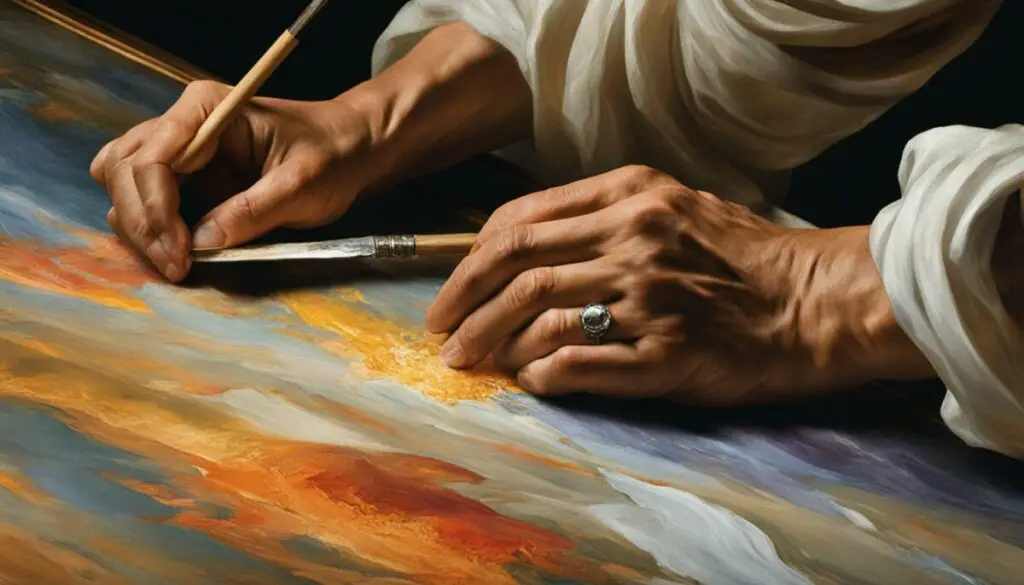
Michelangelo’s approach to painting the Sistine Chapel frescoes involved a range of techniques that showcased his artistic genius. Let’s explore some of the methods he employed to bring his vision to life.
Preparatory Cartoons
In order to streamline the painting process, Michelangelo utilized preparatory cartoons. These were detailed sketches that allowed him to plan and outline the figures before transferring them onto the plaster. This technique provided a foundation for his work and enabled him to maintain consistency in his compositions.
Transfer Technique
Once the preparatory cartoons were completed, Michelangelo used a transfer technique that was similar to stenciling. By pricking holes along the outlines of the figures, he could transfer the design onto the wet plaster. This ensured accuracy and speed in his painting process, allowing him to efficiently execute his artistic vision.
Stenciling
Stenciling was another technique Michelangelo incorporated into his painting process. By using templates or stencils, he could quickly replicate specific patterns or decorative elements across different sections of the frescoes. This technique enhanced the visual cohesiveness and intricate details of his artwork.
Speed and Technique
Michelangelo’s mastery of his craft enabled him to work at an impressive speed. He completed entire panels in a single day, showcasing his efficiency and dedication to his artistic endeavor. Despite the time constraints, his attention to detail and skillful technique remained evident in every brushstroke.
Unique Style
One of the defining aspects of Michelangelo’s painting technique was his unique style. His compositions were dynamic and expressive, featuring sculptural figures that seemed to come to life on the ceiling of the Sistine Chapel. This distinctive style set his frescoes apart from the works of his contemporaries and contributed to their enduring impact.
Michelangelo’s innovative painting techniques, combined with his speed and unique style, resulted in the breathtaking frescoes that adorn the Sistine Chapel. His artistic vision and technical brilliance continue to inspire and captivate audiences to this day.
Challenges and Controversies
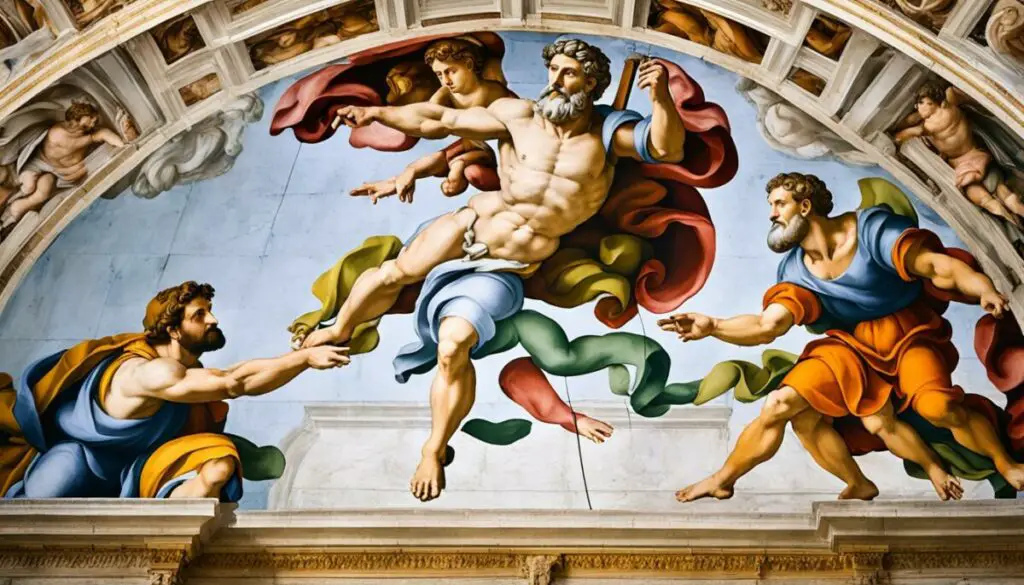
Michelangelo faced various challenges and controversies during the painting process of the Sistine Chapel frescoes. These difficulties ranged from payment issues to subject disagreements and even concerns about religious themes depicted in his artwork. Let’s explore some of the notable challenges and controversies that Michelangelo encountered:
Payment Issues with Pope Julius II
One of the challenges Michelangelo faced was related to payment. While working on the Sistine Chapel, he experienced payment issues with Pope Julius II, who commissioned the project. This financial strain added further pressure to Michelangelo throughout the painting process.
Subject Disagreements
Michelangelo also encountered disagreements regarding the subject matter of the frescoes. As an artist with a unique vision, he expressed his creative ideas and pushed boundaries. However, these artistic choices sometimes clashed with the expectations of his patrons and caused disagreements.
Difficulties with Religious Themes
The religious themes depicted in Michelangelo’s artwork also sparked controversies. One of the most famous examples is The Last Judgment, which generated criticism due to its portrayal of nudity. This led to later attempts to censor or alter the artwork to align with the prevailing moral standards of the time.
Renovation and Preservation Efforts
Over the years, the Sistine Chapel frescoes underwent renovations and preservation efforts. Some additions and alterations were made to cover or remove certain elements that were deemed inappropriate or controversial. However, many art critics and enthusiasts appreciate the frescoes in their original form, acknowledging their historical and artistic significance.
The Last Judgment and its Impact
Pope Clement VII commissioned Michelangelo to create a monumental fresco called The Last Judgment on the wall behind the altar of the Sistine Chapel. This request marked a significant moment in Michelangelo’s artistic career and added to the grandeur of the chapel. The Last Judgment depicts a scene of Jesus Christ surrounded by figures laying on clouds, while others face judgment. The composition and scale of the artwork are awe-inspiring, capturing the intensity and significance of this biblical event.
The inclusion of nudity in The Last Judgment caused controversy during the time of its creation. The depiction of naked bodies sparked debate and criticism among religious and secular authorities. In response to this controversy, Daniele Volterra was commissioned during Napoleon’s invasion to add clothing to the figures. Despite these alterations, The Last Judgment remains a masterpiece, showcasing Michelangelo’s exceptional skill in capturing complex emotions and creating a dramatic visual narrative.
Symbolism and Meaning
The Last Judgment holds deep symbolism, with each figure and element contributing to its overall message. The central figure of Jesus Christ symbolizes divine judgment and the power of salvation. The figures surrounding Christ represent both the saved and the damned, portraying a wide range of emotions and spiritual states.
Michelangelo’s portrayal of the human form in The Last Judgment is a testament to his ability to convey the complexity of the human experience and the eternal consequences of one’s actions.
Through his mastery of anatomy, composition, and expression, Michelangelo captures the fear, hope, agony, and longing present in this divine scene. The nudity of the figures emphasizes the vulnerability and honesty of the human soul in the face of judgment.
Impact and Legacy
The Last Judgment remains an influential and enduring artwork in the history of Western art. It has inspired countless artists and continues to captivate audiences with its emotional intensity and visual grandeur. The scene’s themes of salvation, redemption, and divine justice resonate deeply with viewers, inviting contemplation of life’s choices and the ultimate consequences.
Despite the controversies and alterations it has undergone throughout history, The Last Judgment stands as a testament to Michelangelo’s genius and his ability to create enduring masterpieces that transcend time and cultural boundaries.
Appreciating the Sistine Chapel Today
Today, the Sistine Chapel holds a significant place as a sacred venue for masses and ceremonies, including the Election of the Pope. It offers visitors a unique opportunity to immerse themselves in the awe-inspiring atmosphere of this historical and sacred place. The sheer grandeur and beauty of Michelangelo’s frescoes, which adorn the chapel’s walls and ceiling, make it a truly remarkable and unforgettable experience.
The Sistine Chapel’s visitor experience is filled with reverence and wonder as people from all walks of life gather to witness the famous artworks housed within its hallowed walls. The mastery displayed in Michelangelo’s artwork leaves beholders in awe, appreciating the profound significance of these renowned masterpieces.
Preservation and restoration efforts have played a crucial role in ensuring that future generations can continue to marvel at the splendor and historical significance of the Sistine Chapel. The delicate process of preserving and restoring the frescoes requires immense care and expertise to maintain their original beauty and integrity. Through these efforts, the breathtaking frescoes continue to inspire and captivate audiences, enabling them to connect with the artistry of Michelangelo and the historical significance of the chapel itself.
The Sistine Chapel’s significance extends beyond its artistic and cultural value. It serves as a testament to human creativity, spirituality, and the pursuit of divine beauty. Standing within its sacred walls, one can feel the weight of history and the profound impact that this extraordinary place has had on countless individuals over the centuries.
In conclusion, the Sistine Chapel stands as a beacon of artistic achievement, preservation, and restoration. Its sacredness, masses, and ceremonies continue to draw in visitors from around the world who seek to appreciate the famous artworks and experience the awe-inspiring aura of this extraordinary place. The Sistine Chapel remains a testament to the enduring power of human creativity, touching the souls of all who have the privilege of visiting this hallowed sanctuary.
Conclusion
Michelangelo’s artistic legacy in the Sistine Chapel is nothing short of a masterpiece. His stunning frescoes continue to mesmerize viewers with their technical brilliance, narrative depth, and symbolic richness. The Sistine Chapel stands as a testament to Michelangelo’s remarkable talent and remains one of the world’s most treasured artistic achievements.
Through his meticulous brushwork and innovative techniques, Michelangelo brought to life biblical scenes and figures with unparalleled beauty and realism. His skillful use of composition, perspective, and expression in works like “The Creation of Adam” and “The Last Judgment” showcase his unparalleled mastery of the art form.
Today, the Sistine Chapel serves as a living testament to Michelangelo’s artistic genius and a symbol of human creativity and aspiration. It continues to be a place of pilgrimage for art lovers, historians, and visitors from around the world who are captivated by the awe-inspiring beauty of Michelangelo’s frescoes. The artistic legacy that Michelangelo left behind in the Sistine Chapel will forever inspire and enrich the lives of those who have the privilege of experiencing its splendor.
FAQ
How did Michelangelo paint the frescoes of the Sistine Chapel?
Michelangelo painted the frescoes of the Sistine Chapel using various techniques, including the use of preparatory cartoons to transfer outlines onto the plaster, similar to stenciling. He worked with speed and efficiency, completing entire panels in a single day.
What painting techniques did Michelangelo use?
Michelangelo employed unique painting techniques, characterized by dynamic compositions and sculptural figures. He utilized preparatory cartoons and transferred the sketches onto the plaster. His style distinguished his frescoes from those of his contemporaries.
What was the process of fresco painting used by Michelangelo?
Michelangelo used a fresco painting process that involved applying pigments mixed with water onto wet plaster. This allowed the pigments to seep into the plaster, creating a durable and long-lasting artwork.
What are the secrets behind Michelangelo’s frescoes in the Sistine Chapel?
The secrets behind Michelangelo’s frescoes lie in his innovative techniques, such as the use of preparatory cartoons, his unique style, and his ability to create dynamic compositions. These factors contributed to the timeless beauty and significance of his artworks.
What were Michelangelo’s step-by-step fresco painting methods?
Michelangelo’s step-by-step fresco painting methods involved first sketching the figures on preparatory cartoons. He would then transfer the outlines onto the wet plaster using a technique similar to stenciling. This allowed him to work efficiently and complete large sections in a short amount of time.
What were Michelangelo’s techniques for painting the Sistine Chapel?
Michelangelo’s techniques for painting the Sistine Chapel involved meticulous planning and the use of preparatory cartoons. He incorporated his unique style and composition skills to create visually stunning frescoes that showcased his mastery of form, expression, and storytelling.
How long did it take Michelangelo to paint the frescoes of the Sistine Chapel?
It took Michelangelo approximately four years, from 1508 to 1512, to paint the frescoes of the Sistine Chapel. During this time, he dedicated countless hours and immense effort to complete the astonishing 5000 square feet of artwork.
What were the secrets behind Michelangelo’s ability to paint such intricate frescoes?
The secrets behind Michelangelo’s ability to paint intricate frescoes lie in his exceptional artistic skill, his understanding of composition, and his meticulous attention to detail. He utilized his knowledge of anatomy and perspective to create lifelike figures and dynamic scenes.
How did Michelangelo overcome the challenges of painting on a high ceiling and dealing with physical discomfort?
Michelangelo designed his own scaffold to overcome the challenges of painting on a high ceiling and dealing with physical discomfort. He rejected another artist’s flawed support structure and created a scaffold that allowed him to work more comfortably and efficiently.
What were the controversies surrounding Michelangelo’s frescoes?
Michelangelo’s frescoes faced controversies surrounding payment issues, subject disagreements, and criticism regarding the appropriateness of certain religious themes portrayed in The Last Judgment. These controversies led to later censorship attempts and renovations of the frescoes.

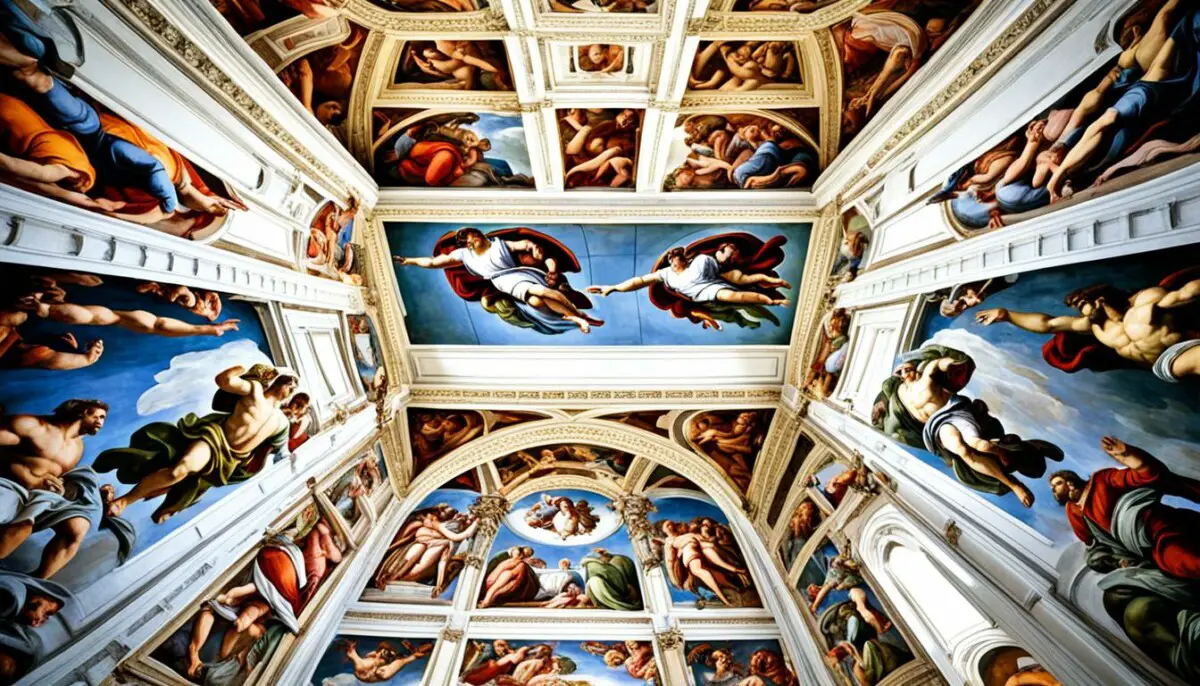

.jpg)




